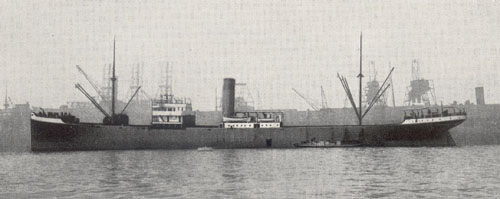
The Bintang was built for Stoomvaart Maatschappij Nederland Line, Amsterdam, being launched in 1916. Originally with steam propulsion, it was converted 1925 along with the Wieringen for use on their long haul route from Europe to the Dutch East Indies. The conversion to diesel propulsion was estimated to save £13,500 per year in fuel costs. The cost of conversion was about £70,000. Trials were completed during May 1925 with a speed of 14 knots attained. At the time the Bintang was the highest-powered single-screw motor vessel afloat. The original 3,600ihp triple expansion engine running at 85rpm gave a speed of 12 knots. The daily fuel consumption as a steamer was about 58 tons, as a motorship it was estimated to be 14.7 tons. Bunker capacity for the fuel order was 2,000 tons. At the time of conversion the steering was converted to electrical operation, using equipment supplied by Messrs Laurence Scott & Company.
After twenty three years of peacetime service the arrival of World War Two found the Bitang supporting the Allies in the movement of supplies from many parts of the world to the United Kingdom.
Convoys that included the Bitang were:
1940
SL/MKS.40 Freetown July 16th - Liverpool August 8th with the Bitang carrying general cargo joining as part of Convoy SL/MKS.40F which left Freetown on July 20th and rendezvoed with SL.40 on August 1st general cargo
WN.8 Clyde August 16th - Methil August 19th
FS.258 Methil August 20th - Southend August 22nd
FN.289 Southend September 23rd - Methil September 25th
OA.221 Methil September 28th - dispersed Oct 2nd
1941
HX.102 Halifax January 11th - Liverpool January 29th with steel & general cargo
OB.297 Liverpool March 12th - dispersed 61.28N 21.59W March 17th with general merchandise for Freetown & Java
HX.154 Halifax October 10th - Liverpool October 23rd) with sugar, passengers and mail
BB.96 Belfast Lough November 2nd - Milford Haven November 4th
ON.38 Liverpool November 19th - dispersed 54.30N 51.00W - November 30th
ON.44 Liverpool December 7th - Dispersed 15th carrying iron floats to Singapore
1942
XB.5 Halifax March 27th - Boston March 29th
CO.8 Newcastle NSW July 2nd - Melbourne July 6th, the Bitang was recorded as arriving with an engine defect
On September 23rd 1942 the Bintang set out from Calcutta bound for Table Bay, Saldanha Bay, Trinidad, Canada & the United Kingdom under Master J T Rigter. On the afternoon of November 20th 1942 the ship was travelling unescorted some 700 miles east of Trinidad when it came under surveillance from the U-160. At about 9.26am on the 21st the U-160 hit the port side of the ship with two torpedoes, two other fired earlier had missed. Of the 73 crew, 22 were killed in the attack and sinking, whilst the 51 survivors were left only with life rafts after the four lifeboats were either destroyed in the attack or went down with the ship. The Bintang sank at position 10.30N, 51.00W.
The five rafts containing the survivors drifted apart with each having a story to tell. The rescue of the first raft was made by the Spanish merchant ship Monte Altube after seven days adrift, the survivors were taken to Rio Grande. Ten days later two rafts were found, one by a US Navy patrol boat and one with 12 survivors by the British merchant ship Rodsley, the latter being landed at Port of Spain. After 22 days the Black Point found the fourth raft and took the survivors to Georgetown. Eight days later the fifth raft came ashore at Trinidad.
Builder: Mij. Fijenoord, Rotterdam
Launched: 1916 original, converted to diesel 1925
Length: 438 feet
Beam: 54 feet
Draught: 36 feet
Weight: 6,568 tons total, 4,518 tons below deck, 4,099 tons net
Deadweight: 13,600 tons
Engines: One Sulzer (Winterthur) 6S76 engine producing 3,600hp at 90rpm
Auxiliary engines: Two x Sulzer 2RH27 and one 4RH27 producing 320hp at 300rpm
Screws:
Service Speed: 12 knots
Page added October 14th 2009.
Last updated February 3rd 2018.
Return to Ship menu
Return to site menu